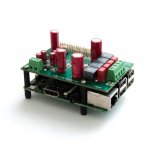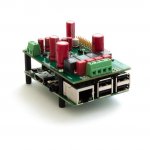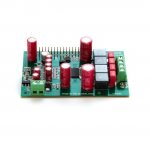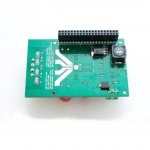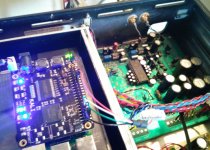>SNIP>
Basically the main idea belongs to Ian's. His hardware is actually superior to ours , mostly in the way he implemented the clocks and to the attention of the detail (like mounting xtals on a pcb supported by elastics ). So we credit Ian's idea and his great design.
Our hardware/soft is not a copy , its an implementation of the same idea. We use a FPGA and sram to buffer the DATA and we reclock bclk/mclk outside the FPGA using NDK (or Crystek) . The board has an eprom but its not HAT complaint (because of the space). FCC will be available for the board.
Main reason for making the board was to try to correct the audio clocks of SBCs and bring high quality audio to anyone that has an SBC around..for a great price.
<SNIP>
1. Yes of course its possible. Actually we are looking right now at the new generation Kali reclocker. Its not the FPGA that sends the i2s signals out (because of the high jitter inherent to fpga silicon) . The re-cloaking its done at output of FPGA using flipflops
<SNIP>
Pricing ---cheaper than 80$ ( we are still having internal discussions)
FCC/CE approved
Just in case, some FYI's.
Greg in Mississippi
Last edited:
It's the price of the Piano DAC and the AMP board, I'm concerned about.
Nope no XLR out.
@cdsgames: Off topic (non FIFO) in the mean time... regarding those parallel Dacs. How close is it to differential balanced? Could you set it to that in software, and attach some XLR's out? (Did you plan for that?)
Hi Clive ,
The DAC ic is important but implementation is even more so... we are using 2 LDOs one for digital and second for analog stage..the analog LDO is LT3042 that has a very high PSRR even at 1Mhz.
In addition we filter the high frequency noise using inductors...so I think its a different (hardware) implementation of the TI IC.
Regarding CM , we will publish the oscilloscope data next week...but basically what you will see is a 50db reduction in noise..you might not hear it (difference) but I am certain some people will.. most PS will be changed from 70mV of ripple/150mV noise to something closer to 8mV (for both)..its very hard to get under 6mV because of PCBs placement etc...
Most literature on PSU/classD AMP say that anything above 10mV its audible..
Regarding Volt amp...thats strange because we are using the lowest gain (20db or 26db I don't recall exactly )
The DAC ic is important but implementation is even more so... we are using 2 LDOs one for digital and second for analog stage..the analog LDO is LT3042 that has a very high PSRR even at 1Mhz.
In addition we filter the high frequency noise using inductors...so I think its a different (hardware) implementation of the TI IC.
Regarding CM , we will publish the oscilloscope data next week...but basically what you will see is a 50db reduction in noise..you might not hear it (difference) but I am certain some people will.. most PS will be changed from 70mV of ripple/150mV noise to something closer to 8mV (for both)..its very hard to get under 6mV because of PCBs placement etc...
Most literature on PSU/classD AMP say that anything above 10mV its audible..
Regarding Volt amp...thats strange because we are using the lowest gain (20db or 26db I don't recall exactly )
Check that the right channel is really the right and left, the left. I think the channels are swapped.
I'm just gonna say this.... A pig is a pig. Put a dress on it and paint it with lipstick and it still OINKS!!!!I'm way too familiar with the TI junk.... Minus the Kali, the Piano is no better or worse than half a dozen other TI PCM5x DAC's that have been though my hands. The CM.... Not sure. (I've been using the AMP, complete stack, this afternoon). I can't hear any sound difference with or without the CM. (Perhaps that says more about the quality of the Dell laptop PS than anything else....) The AMP board is not better/worse than several similar products that I'm also familiar with. ie. the HB and IQ variants with TI chips.
The unique selling point of the Piano DAC is the 2.1. The way the upload of DSP is implemented from the kernel driver, rather than userspace, means it is unlikely to find its way into any distribution in current form. Meaning this DAC is gonna be 2 channel only unless you are willing to run their own distribution.....
I also find it objectionable, that there is way too much gain with the amp, that you need to attenuate so heavily in the digital domain. -36db, for my usual listening level and I'm not using particularly sensitive speakers. (In any case, I wouldn't dream of connecting this type of kit to the horns...)
We will announce it very soon. Give me a few more days (before end of next week)
But I will say this...we will blow everyone out of the water as far as quality/price.
But I will say this...we will blow everyone out of the water as far as quality/price.
It's the price of the Piano DAC and the AMP board, I'm concerned about.
Hi skcramer ,
how would you say its the sound compared with any other Ti based DACs that you have around ? (2.0)
Also , we will get our code cleaned and included in the oficial dist..meanwhile can you just test our own distri and give your opinion how the 2.1 sounds ?
how would you say its the sound compared with any other Ti based DACs that you have around ? (2.0)
Also , we will get our code cleaned and included in the oficial dist..meanwhile can you just test our own distri and give your opinion how the 2.1 sounds ?
I really get what you are saying, after being fairly familiar with the D+Pro PCM5xxx! It's like Kali is giving thick focused details top to bottom, yet that same-old character is there-- need to listen more (headphones and big system), that's for sure. The Kali is the cool thing.
Looks like max2play is the plan for their own dist... but yeah, starting small in 2.0 mode is probably the way to go, to get in the official dist!
Then figure out the 2.1 DSP after that. Only way to make it really popular!
But I will say this...we will blow everyone out of the water as far as quality/price.
Ioan, with the greatest respect, I would suggest you tone it down a bit. These are your babies. I get that. I get you are proud of your babies and think they are the best thing since sliced bread.
that might be a bit of an overstatement yeah 
Seriously, we will have great pricing. I am still fighting to get it. Will post something before Wednesday.
Seriously, we will have great pricing. I am still fighting to get it. Will post something before Wednesday.
Ioan, with the greatest respect, I would suggest you tone it down a bit. These are your babies. I get that. I get you are proud of your babies and think they are the best thing since sliced bread.
Seriously, we will have great pricing. I am still fighting to get it. Will post something before Wednesday.
I've got a question for you.... You must have done your homework, right? You must know what you are going up against with your DAC/AMP combo? I'm not talking about the usual HB/IQ fodder.... I'm talking about something like the Dion Audio LOCO.
Attachments
Its kind of hard to comment on hardware that's not public , with unknown pricing or quality.
Market is big enough for everyone and customers will chose what they think its best.
PS. I found a link for the above HAT selling at 199 (hat + rpi I think )...second aren't they using the TI combo IC (pcm5102 + tpa3116 AMP ) ??
Market is big enough for everyone and customers will chose what they think its best.
PS. I found a link for the above HAT selling at 199 (hat + rpi I think )...second aren't they using the TI combo IC (pcm5102 + tpa3116 AMP ) ??
I've got a question for you.... You must have done your homework, right? You must know what you are going up against with your DAC/AMP combo? I'm not talking about the usual HB/IQ fodder.... I'm talking about something like the Dion Audio LOCO.
Last edited:
Its kind of hard to comment on hardware that's not public , with unknown pricing or quality.
Obviously, I have one and I think it is the current benchmark for all other TI DAC/AMP combos..... It was being sold via a web site in the Netherlands, ISTR.
Market is big enough for everyone and customers will chose what they think its best.
Yes, I agree. But many things you say, seem to point at you thinking that you have a premium product, where you have thought about many things that others have not even considered. There are several "boutique" products out there now, which have moved the goalposts from what everyone else was aiming at a year ago, ie. the HB's and IQ's. These products might not be easily available via global distribution, but they are available!
I'm still waiting for SC to chime in on my pig comment after he spent time and money finding that you cannot turn a pig into a prize winning racehorse.
PS. I found a link for the above HAT selling at 199 (hat + rpi I think )...second aren't they using the TI combo IC (pcm5102 + tpa3116 AMP ) ??
PCM5242 in hardware mode (not I2C connected) and TPA3118, ISTR.
@cdsgames I didn't hear from you yesterday. I did an overlay, that if I were to submit a PR for now, would possibly make it into the next Raspbian kernel build. Obviously, just 2 channel ('basic' support) as I said before, and piggy-backing on the IQaudIO machine driver, and using a completely unmodified pcm512x codec driver.
Do you want me to submit it as a PR to RPi github?
/boot/config.txt
squeezelite config
Do you want me to submit it as a PR to RPi github?
/boot/config.txt
Code:
dtoverlay=allo-piano-dac-basic-audiosqueezelite config
Code:
AUDIO_DEV="-o hw:CARD=Piano"
Code:
$ alsacap
*** Scanning for playback devices ***
Card 1, ID `Piano', name `Piano'
Device 0, ID `Piano DAC HiFi pcm512x-hifi-0', name `', 1 subdevices (1 available)
2 channels, sampling rate 8000..384000 Hz
Sample formats: S16_LE, S24_LE, S32_LE
Subdevice 0, name `subdevice #0'Attachments
Last edited:
We have now over 30 people reviewing our products and we think that each will bring there unique point of view/taste to the review. Overall , that many reviews , will show a pattern that's beyond individual taste.
One thing that I am very confident is the implementation and filtering that we brought to the Dac/Amp . Every capacitor , LDO was debated , even how much cooper/oz on the AMP. The resistors and capacitors on audio path (both Dac and Amp) where chosen because of the audio quality (thin film and poly capacitor)
Our products are not design to be hi end, we want to bring excellent hardware for a low price for everyone to enjoy.
One thing that I am very confident is the implementation and filtering that we brought to the Dac/Amp . Every capacitor , LDO was debated , even how much cooper/oz on the AMP. The resistors and capacitors on audio path (both Dac and Amp) where chosen because of the audio quality (thin film and poly capacitor)
Our products are not design to be hi end, we want to bring excellent hardware for a low price for everyone to enjoy.
First Observations on the Kali
I got my Kali up and running as an I2S source for my Pedja Rogic AYA DAC yesterday. Plugged it in, powered up and it just worked. A good start! I have previously used a CD-Pro2 Mech with a TentLabs clock modification to play CDs. More recently I have been using a Raspberry Pi2 and a HifiBerryDAC+ Pro with a linear PSU and Moode 2.7 MPD player. Files are FLAC on a NAS wireless to the Pi.
I could with little effort swap each source out, so today I thought it would be interesting to compare all three I2S sources with the same music selection. I thought that break in for the Kali shouldn't really matter too much. I do acknowledge that there are a whole heap of variables changing here with each configuration, but nonetheless I thought there would be merit in seeing what flavours appeared in the comparisons!
1) CD-Pro2: This is the presentation I'm most used to and will use as reference.
2) DAC+ Pro: DAC+ Pro selected in the player. Software volume control disabled. Immediately the image is more diffuse than the CD mech, detail disappears into ambience all washed into mush. Bass is noticeably less defined and pitch is less discernible. Treble has reasonable harmonic structure and reasonable detail, although less so than the CD Mech and a bit soft. Having said that the presentation is pleasing and not particularly fatiguing.
3) Kali: Generic I2S (rpi-dac) selected in the player. Software volume control disabled. Very good levels of low level detail, layers nicely separated, edges the CD-Pro2 slightly I'd say. The sound stage opens nicely as a result, very pleasing. Bass blurring is gone with the bonus of excellent pitch definition. High frequencies are interesting. The Kali seems to have a slightly more forward presentation than the other two in my particular configuration. The HF detail is very good but there is a subtle hint of steel there, which is less noticeable with the other two sources. The CD Mech is just a tad cleaner and the DAC Pro+ just masks that kind of subtle harmonic information completely.
So my first thoughts are the Kali has really serious potential as a Pi I2S source. I think that my first attempt to remove the last remaining traces of digititus from the sound would be to separate the Pi ground from the DAC ground. That ground can't be very clean and maybe a route for RF into the DAC? A Twisted Pear Transporter might be the answer with the bonus of being able to put the Pi+Kali in a separate enclosure. I think Ian has something on the way too. Exciting times!
I got my Kali up and running as an I2S source for my Pedja Rogic AYA DAC yesterday. Plugged it in, powered up and it just worked. A good start! I have previously used a CD-Pro2 Mech with a TentLabs clock modification to play CDs. More recently I have been using a Raspberry Pi2 and a HifiBerryDAC+ Pro with a linear PSU and Moode 2.7 MPD player. Files are FLAC on a NAS wireless to the Pi.
I could with little effort swap each source out, so today I thought it would be interesting to compare all three I2S sources with the same music selection. I thought that break in for the Kali shouldn't really matter too much. I do acknowledge that there are a whole heap of variables changing here with each configuration, but nonetheless I thought there would be merit in seeing what flavours appeared in the comparisons!
1) CD-Pro2: This is the presentation I'm most used to and will use as reference.
2) DAC+ Pro: DAC+ Pro selected in the player. Software volume control disabled. Immediately the image is more diffuse than the CD mech, detail disappears into ambience all washed into mush. Bass is noticeably less defined and pitch is less discernible. Treble has reasonable harmonic structure and reasonable detail, although less so than the CD Mech and a bit soft. Having said that the presentation is pleasing and not particularly fatiguing.
3) Kali: Generic I2S (rpi-dac) selected in the player. Software volume control disabled. Very good levels of low level detail, layers nicely separated, edges the CD-Pro2 slightly I'd say. The sound stage opens nicely as a result, very pleasing. Bass blurring is gone with the bonus of excellent pitch definition. High frequencies are interesting. The Kali seems to have a slightly more forward presentation than the other two in my particular configuration. The HF detail is very good but there is a subtle hint of steel there, which is less noticeable with the other two sources. The CD Mech is just a tad cleaner and the DAC Pro+ just masks that kind of subtle harmonic information completely.
So my first thoughts are the Kali has really serious potential as a Pi I2S source. I think that my first attempt to remove the last remaining traces of digititus from the sound would be to separate the Pi ground from the DAC ground. That ground can't be very clean and maybe a route for RF into the DAC? A Twisted Pear Transporter might be the answer with the bonus of being able to put the Pi+Kali in a separate enclosure. I think Ian has something on the way too. Exciting times!
Attachments
Last edited:
Simon,
Thanks for your very complete and informative reply. My Kali is still making its way through customs, I hope I will have it in hand this week.
My main focus will be using it to clean up the I2S into an orginal Mamboberry DAC. It is in a setup where the R-Pi and Mamboberry already each have separate power supplies and I have another supply in that setup that I can use to power the Kali separately. I am hopeful it will make a significant difference there. And I also hope it will make Sync mod on the ES9023 DAC a viable option.
I'll also try it with an IQAudio DAC and to feed a Buffalo DAC in place of an Ian reclocker setup.
I LOVE your idea on using TP Teleporters to provide some isolation from the Pi. I have some here I can slot in for a quick try.
And I'm interested in seeing what the Allo.com isolator board will do. I DO hope they plan for it to fit between the Pi and the Kali... after the Kali means that the nicely reclocked I2S will be re-jittered by the isolators. Pity they can't easily setup a split reclocker with the isolators just before the final clocks and reclocking flipflops.... but that adds a lot of complexity to the setup, including the need for another power supply. At that point, I'm not sure why one doesn't just go with Ian's setup.
I still suspect good supplies on the Pi along with Op Sys & SW tweaks to get the best I2S out will remain important, tho.
But I'm happy the Kali makes the difference you reported... definitely a good start!
Thanks for the first read on that.
Greg in Mississippi
Thanks for your very complete and informative reply. My Kali is still making its way through customs, I hope I will have it in hand this week.
My main focus will be using it to clean up the I2S into an orginal Mamboberry DAC. It is in a setup where the R-Pi and Mamboberry already each have separate power supplies and I have another supply in that setup that I can use to power the Kali separately. I am hopeful it will make a significant difference there. And I also hope it will make Sync mod on the ES9023 DAC a viable option.
I'll also try it with an IQAudio DAC and to feed a Buffalo DAC in place of an Ian reclocker setup.
I LOVE your idea on using TP Teleporters to provide some isolation from the Pi. I have some here I can slot in for a quick try.
And I'm interested in seeing what the Allo.com isolator board will do. I DO hope they plan for it to fit between the Pi and the Kali... after the Kali means that the nicely reclocked I2S will be re-jittered by the isolators. Pity they can't easily setup a split reclocker with the isolators just before the final clocks and reclocking flipflops.... but that adds a lot of complexity to the setup, including the need for another power supply. At that point, I'm not sure why one doesn't just go with Ian's setup.
I still suspect good supplies on the Pi along with Op Sys & SW tweaks to get the best I2S out will remain important, tho.
But I'm happy the Kali makes the difference you reported... definitely a good start!
Thanks for the first read on that.
Greg in Mississippi
Hi Simon ,
I agree, ground should be separated..even though we use a PI filter with a very low cutoff frequency the attenuation is about 24-30db for HF (not enough for true HIFI)
Best solution is the isolator board. Next week , we will post a diagram and explain all signals we want to isolate before we go to mass production.
We will take the help of community .
I agree, ground should be separated..even though we use a PI filter with a very low cutoff frequency the attenuation is about 24-30db for HF (not enough for true HIFI)
Best solution is the isolator board. Next week , we will post a diagram and explain all signals we want to isolate before we go to mass production.
We will take the help of community .
So my first thoughts are the Kali has really serious potential as a Pi I2S source. I think that my first attempt to remove the last remaining traces of digititus from the sound would be to separate the Pi ground from the DAC ground. That ground can't be very clean and maybe a route for RF into the DAC? A Twisted Pear Transporter might be the answer with the bonus of being able to put the Pi+Kali in a separate enclosure. I think Ian has something on the way too. Exciting times!
Hi Greg
you got it..isolator will be betwen SBC and Kali
you got it..isolator will be betwen SBC and Kali
And I'm interested in seeing what the Allo.com isolator board will do. I DO hope they plan for it to fit between the Pi and the Kali... after the Kali means that the nicely reclocked I2S will be re-jittered by the isolators.
But I'm happy the Kali makes the difference you reported... definitely a good start!
Thanks for the first read on that.
Greg in Mississippi
Hi Greg
The thing I find attractive about the TP Transporter is that it breaks the ground immediately before the DAC which, provided no additional jitter is introduced, is the optimum place. But then isolating the Kali from the Pi might be just as beneficial. Of course I'd love to know how you get on with trying it!
Ian's FIFO plus isolator looks a beautiful solution but it's not inexpensive. I understand exactly why that is, and I appreciate his efforts.
I agree, but this is where I am out of my depth, I have to keep it simple when it comes to code! Hats off to you, soundcheck and others here for raising awareness and sharing your knowledge on the software side.
I LOVE your idea on using TP Teleporters to provide some isolation from the Pi. I have some here I can slot in for a quick try.
The thing I find attractive about the TP Transporter is that it breaks the ground immediately before the DAC which, provided no additional jitter is introduced, is the optimum place. But then isolating the Kali from the Pi might be just as beneficial. Of course I'd love to know how you get on with trying it!
Ian's FIFO plus isolator looks a beautiful solution but it's not inexpensive. I understand exactly why that is, and I appreciate his efforts.
I still suspect good supplies on the Pi along with Op Sys & SW tweaks to get the best I2S out will remain important, tho.
I agree, but this is where I am out of my depth, I have to keep it simple when it comes to code! Hats off to you, soundcheck and others here for raising awareness and sharing your knowledge on the software side.
- Home
- Vendor's Bazaar
- New FIFO buffer for RPI/SBCs
